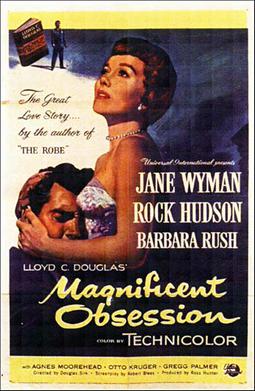 |
| Lana Turner and Juanita Moore in Imitation of Life |
Lora Meredith: Lana Turner
Annie Johnson: Juanita Moore
Steve Archer: John Gavin
Sarah Jane Johnson: Susan Kohner
Susie Meredith: Sandra Dee
Allen Loomis: Robert Alda
David Edwards: Dan O'Herlihy
Sarah Jane, age 8: Karin Dicker
Susie, age 6: Terry Burnham
Frankie: Troy Donahue
Choir Soloist: Mahalia Jackson
Director: Douglas Sirk
Screenplay: Eleanore Griffin, Allan Scott
Based on a novel by Fannie Hurst
Cinematography: Russell Metty
Art direction: Alexander Golitzen, Richard H. Riedel
Film editing: Milton Carruth
Music: Frank Skinner
John Gavin was Hollywood's ultimate decorative male, there to look good in bed with Janet Leigh in
Psycho (Alfred Hitchcock, 1960) but otherwise to play no significant role in the film. (When he shows up later with Vera Miles, playing Leigh's sister, to find out what happened to Marion Crane, she's the one who does all the work, including the discovery of the mummified Mrs. Bates in the cellar.) It's no surprise that when Gavin died recently, several of the obituaries mentioned the scene in
Thoroughly Modern Millie (George Roy Hill, 1967) in which his character is paralyzed by a poison dart: He's been presented as so handsomely wooden that it takes a long time before anyone notices he's just sitting there. He's not quite so inert in
Imitation of Life, but that's because Douglas Sirk, like Hitchcock, knew how to make use of him: He's there to hang as nicely on Lana Turner's arm as the Jean Louis gowns do on her body. Unfortunately, this makes for some of the film's weaker scenes, the ones in which Sandra Dee's Susie develops a crush on him, but even there the fault is more Dee's limitations as an actress than Gavin's as an actor. He comes off much better in one of the key scenes, in which his Steve Archer proposes to Turner's Lora Meredith. It works because Turner is skillful enough to make Lora into a woman who knows how not to get trapped by male expectations of what women should be. It's not quite so well-played as the scene in
Now, Voyager (Irving Rapper, 1942) I wrote about a couple of days ago, in which Charlotte Vale rebuffs Jerry Durrance's suggestion that she should be looking for a man instead of taking care of his daughter, but that's because Lana Turner wasn't Bette Davis. Still, the scene comes off, and it's reinforced later when Lora is the one who proposes to Steve, after she's gotten what she wanted. The film belongs, of course, to the women, not only Turner but also and especially to Juanita Moore and Susan Kohner, who got the Oscar nominations they deserved. It's possible to fault the film for "whitewashing" by casting Kohner as the black girl who tries to pass for white, especially since in the earlier version of
Imitation of Life (John M. Stahl, 1934), the corresponding character was played by Fredi Washington, who was indeed black. But even to raise the issue of "passing" in 1959, especially in a film that some considered little more than soap opera, was audacious: The Production Code had long forbidden any treatment of miscegenation. And Sirk artfully turns the issue into a generational one: Sarah Jane's desire to be white as a reaction against the subservience of her mother, foreshadowing a generation gap that would be operative in the coming decade's civil rights struggle. Sirk's films have a way of working themselves into your head unexpectedly, putting the lie to my observation that drama makes you think and melodrama makes you feel. Sirk's melodrama --
Imitation of Life is unashamed of the clichés it exploits and usually transcends -- undoubtedly makes you feel. Is there ever a dry eye at showings of the film's funeral finale? But by confronting the problems that underlie the melodrama it also has a sneaky way of making you think.







